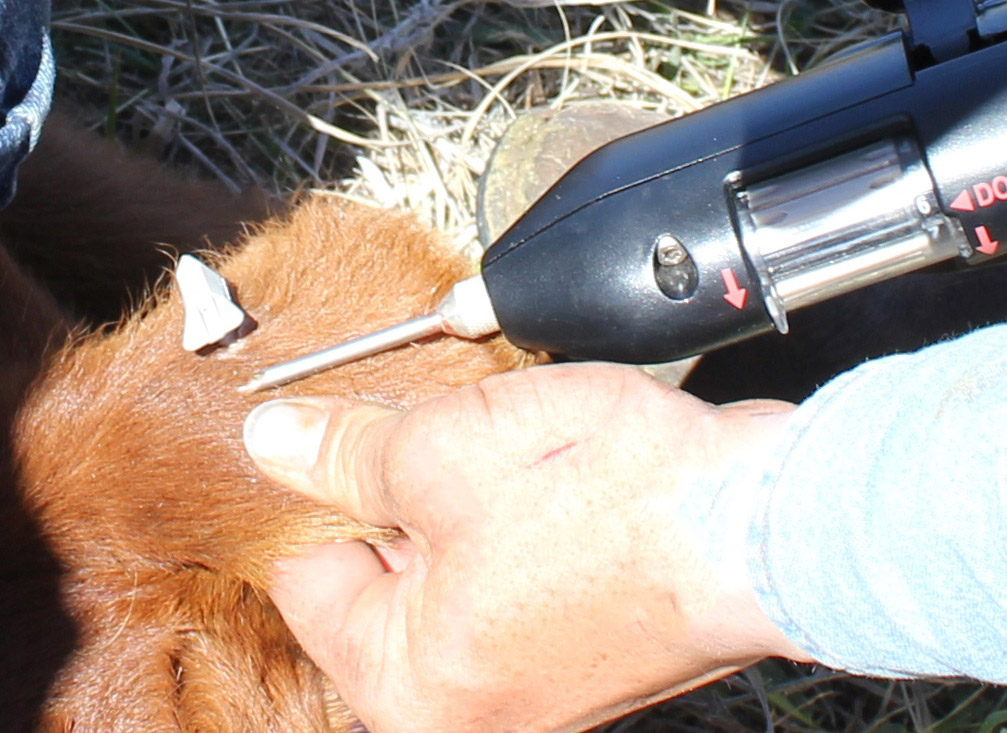
By Erin Laborie, Nebraska Extension Educator, Beef Systems
The use of growth implants has shown to be an effective tool in increasing production from the ranch to the feedlot. Implants cause a delay in fat deposition and an increase in lean tissue accretion while ultimately changing frame size. These growth promotants have been reported to increase gains of suckling calves by four to six percent (Griffin and Mader, 1997). This can result in an additional 15 to 30 pounds of weaning weight, which equates to approximately $20 to $40 in returns per head. With the cost of a calfhood implant (Ralgro®, Synovex® C, Component® E-C) being less than $1.50 per head, it only takes a few pounds to pay for the initial investment.
Implants are used extensively in the feedlot sector, yet less than 30% of cow-calf operations utilize this proven technology. Concerns regarding price received for implanted calves at sale time and the impact of calfhood implants on subsequent performance have made producers hesitant to implant suckling calves. A recent analysis of calves sold through Superior Livestock from 2010 to 2013 indicated that implant status of the calves had no effect on sale price (Rogers et al., 2015). Additionally, research has shown that implanting calves during the suckling phase has no negative impact on subsequent performance or carcass quality (Duckett and Andrae, 2001; Pritchard et al., 2015). Poor experiences associated with implant use are oftentimes inconsistent but can be linked to implanting technique and cattle management.
Matching implant strategy to cattle type (age, sex, genetics) and nutrition program is critical for the appropriate payout to occur. Follow product label directions and recommendations for proper implant administration. Branding is a convenient yet appropriate time to implant suckling calves. To ensure that reproductive performance is not compromised, avoid implanting replacement heifers and bull calves intended for breeding. Variation from year to year in growth response of implanted calves can be driven by environmental factors such as grass quality and availability. Research at South Dakota State University reported little weight gain in calves receiving an implant at branding time during a drought; however, calves of mature cows were 40 pounds heavier at weaning time during a normal year (Pritchard et al., 2015). Plane of nutrition has to be appropriate to support the increased lean gain potential of implanted cattle.
As branding season approaches, consider using calfhood implants as a management strategy to maximize returns. For more information on implanting calves, please see, “Use of Growth Implants in Suckling Beef Calves” (http://aces.nmsu.edu/pubs/_b/B218/).
Resources
Duckett, S.K. and J.G. Andrae. 2001. Implant strategies in an integrated beef production system. J. Anim. Sci. (E. Suppl.) E:110-E117.
Griffin, D. and T. Mader. 1997. Beef cattle implant update. Univ. of Nebraska Cooperative Ext. G97-1324-A.
Pritchard, R.H., A.R. Taylor, S.M. Holt, K.W. Bruns, and H.M. Blalock. 2015. Timing of suckling implant influences on weaning weight, post-weaning performance, and carcass traits in steer calves. South Dakota Beef Report. BEEF 2015-08: 40-45.
Rogers, G.M., M.E. King, K.L. Hill, T.E. Wittum, and K.G. Odde. 2015. The effect of growth-promoting implant status on the sale price of beef calves sold through a livestock video auction service from 2010 through 2013. Prof. Anim. Sci. 31:443-447
To listen to BeefWatch podcasts go to: https://itunes.apple.com/us/podcast/unl-beefwatch/id964198047 or paste http://feeds.feedburner.com/unlbeefwatch into your podcast app.